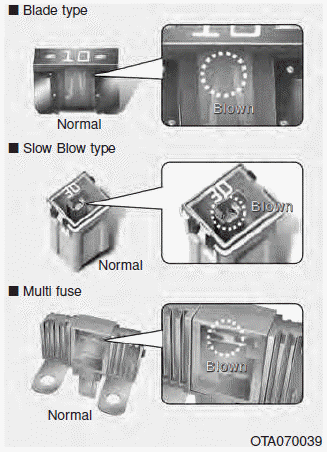Hyundai Creta: Maintenance / Fuses

A vehicle’s electrical system is protected from electrical overload damage by fuses.
This vehicle has 2 fuse panels, one located in the driver’s side panel bolster, the other in the engine compartment near the battery.
If any of your vehicle’s lights, accessories, or controls do not work, check the appropriate circuit fuse. If a fuse has blown, the element inside the fuse will be melted.
If the electrical system does not work, first check the driver’s side fuse panel.
Before replacing a blown fuse, disconnect the negative battery cable. Always replace a blown fuse with one of the same rating.
If the replacement fuse blows, this indicates an electrical problem. Avoid using the system involved and immediately consult an authorized HYUNDAI dealer.
Three kinds of fuses are used: blade type for lower amperage rating, Slow Blow type and multi fuse for higher amperage ratings.
WARNING
Fuse replacement
- Never replace a fuse with anything but another fuse of the same rating.
- A higher capacity fuse could cause damage and possibly a fire.
- Never install a wire or aluminum foil instead of the proper fuse - even as a temporary repair. It may cause extensive wiring damage and a possible fire.
NOTICE
Do not use a screwdriver or any other metal object to remove fuses because it may cause a short circuit and damage the system.
Information
The actual fuse/relay panel label may differ from equipped items.
NOTICE
- When replacing a blown fuse or relay with a new one, make sure the new fuse or relay fits tightly into the clips. The incomplete fastening fuse or relay may cause the vehicle wiring and electric systems damage and a possible fire.
- Do not remove fuses, relays and terminals fastened with bolts or nuts. The fuses, relays and terminals may be fastened incompletely, and it may cause a possible fire. If fuses, relays and terminals fastened with bolts or nuts are blown, consult with an authorized HYUNDAI dealer.
- Do not input any other objects except fuses or relays into fuse/relay terminals such as a driver or wiring. It may cause contact failure and system malfunction.
- Check the blown fuse with the fuse information on the fuse box cover.
- Replace the blown fuse on the same place after turning off the ignition switch and all electric switches and disconnecting the negative battery cable.
- Instrument panel fuse replacement
- Engine compartment panel fuse replacement
- Fuse/Relay panel description
 Low aspect ratio tire
Low aspect ratio tire
The low aspect ratio tires, of which
aspect ratio is below 50, are
equipped with for the sporty look.
Riding with high aspect ratio tires
may be uncomfortable with unpleasant
noises, because ...
 Instrument panel fuse replacement
Instrument panel fuse replacement
1. Turn the ignition switch and all
other switches off.
2. Open the fuse panel cover.
3. Pull the suspected fuse straight
out. Use the fuse puller provided in
the engine compartment fuse
...
Other information:
Lincoln Nautilus 2018-2026 Owners Manual: Switching the Display On and Off
Audio Unit
Press the button.
Touchscreen
To switch the display off:
Press Settings on the touchscreen.
Press Display Settings.
Press Display Off.
Note: The display defaults to on each time
you switch your vehicle on.
To switch the display on, press anywhere on
the touchscreen. ...
Lincoln Nautilus 2018-2026 Owners Manual: Opening and Closing the Moonroof
WARNING: Do not leave children
unattended in your vehicle and do not let
them play with the moonroof. Failure to
follow this instruction could result in
personal injury.
WARNING: When closing the
moonroof, verify that it is free of
obstruction and make sure that children
and pets are not in t ...
